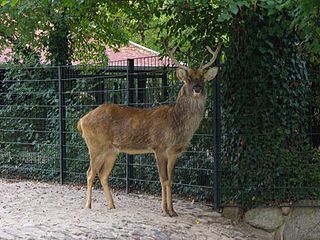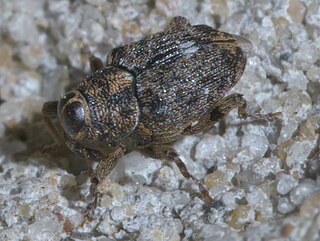Genus is a taxonomic rank used in the biological classification of living and fossil organisms as well as viruses, in biology. In the hierarchy of biological classification, genus comes above species and below family. In binomial nomenclature, the genus name forms the first part of the binomial species name for each species within the genus.

A pine is any conifer in the genus Pinus of the family Pinaceae. Pinus is the sole genus in the subfamily Pinoideae. The Plant List compiled by the Royal Botanic Gardens, Kew and Missouri Botanical Garden accepts 126 species names of pines as current, together with 35 unresolved species and many more synonyms. Pine may also refer to the lumber derived from pine trees; pine is one of the more extensively used types of wood used as lumber.

Vespertilionidae is a family of microbats, of the order Chiroptera, flying, insect-eating mammals variously described as the common, vesper, or simple nosed bats. The vespertilionid family is the most diverse and widely distributed of bat families, specialised in many forms to occupy a range of habitats and ecological circumstances, and it is frequently observed or the subject of research. The facial features of the species are often simple, as they mainly rely on vocally emitted echolocation. The tails of the species are enclosed by the lower flight membranes between the legs. Over 300 species are distributed all over the world, on every continent except Antarctica. It owes its name to the genus Vespertilio, which takes its name from a word for bat, vespertilio, derived from the Latin term vesper meaning 'evening'; they are termed "evening bats" and were once referred to as "evening birds".

Bulbophyllum is a genus of mostly epiphytic and lithophytic orchids in the family Orchidaceae. It is the largest genus in the orchid family and one of the largest genera of flowering plants with more than 2,000 species, exceeded in number only by Astragalus. These orchids are found in diverse habitats throughout most of the warmer parts of the world including Africa, southern Asia, Latin America, the West Indies, and various islands in the Indian and Pacific Oceans. Orchids in this genus have thread-like or fibrous roots that creep over the surface of trees or rocks or hang from branches. The stem is divided into a rhizome and a pseudobulb, a feature that distinguished this genus from Dendrobium. There is usually only a single leaf at the top of the pseudobulb and from one to many flowers are arranged along an unbranched flowering stem that arises from the base of the pseudobulb. Several attempts have been made to separate Bulbophyllum into smaller genera, but most have not been accepted by the World Checklist of Selected Plant Families.

Amrumpronunciation (help·info) is one of the North Frisian Islands on the German North Sea coast, south of Sylt and west of Föhr. It is part of the Nordfriesland district in the federal state of Schleswig-Holstein and has approximately 2,300 inhabitants.

Sorbus is a genus of about 100–200 species of trees and shrubs in the rose family, Rosaceae. Species of Sorbus (s.l.) are commonly known as whitebeam, rowan, service tree, and mountain-ash. The exact number of species is disputed depending on the circumscription of the genus, and also due to the number of apomictic microspecies, which some treat as distinct species, but others group in a smaller number of variable species. Recent treatments treat Sorbus in a narrower sense to include only the pinnate leaved species of subgenus Sorbus, raising several of the other subgenera to generic rank.

In biological classification, taxonomic rank is the relative level of a group of organisms in a taxonomic hierarchy. Examples of taxonomic ranks are species, genus, family, order, class, phylum, kingdom, domain, etc.

Hark Olufs was a North Frisian sailor. He was captured by Algerian pirates and sold into slavery. By successfully working as a slave servant to the Bey of Constantine, he eventually obtained his freedom from captivity.

Rucervus is a genus of deer from India, Nepal, Indochina, and the Chinese island of Hainan. The only extant representative, the barasingha, is threatened by habitat loss and hunting, and another species became extinct in 1938. The species of the genus Rucervus are characterized by a specific antler structure: its basal ramification is often supplemented with an additional small prong, the middle tine is never present, while the crown tines are inserted on the posterior side of the beam and may be bifurcated or fused into a small palmation.
Pedetes primarily refers to Pedetes Illiger, 1811, the genus of the two extant springhare species.

Lechriops is a genus of true weevils in the family of beetles known as Curculionidae. There are at least 90 described species in Lechriops. The genus name is masculine, contrary to some sources, following ICZN Article 30.1.4.3: "A compound genus-group name ending in -ops is to be treated as masculine, regardless of its derivation or of its treatment by its author."

Platyomus is a genus of broad-nosed weevils in the family of beetles known as Curculionidae. There are at least 40 described species in Platyomus.
Phyllotrox is a genus of true weevils in the beetle family Curculionidae. There are at least 60 described species in Phyllotrox.
Pterocolus is a genus of thief weevils in the beetle order Coleoptera. There are about 16 described species in Pterocolus.
Orthognathus is a genus of snout and bark beetles in the family Dryophthoridae. There are about seven described species in Orthognathus.
Eulechriops is a genus of true weevils in the beetle family Curculionidae. There are more than 80 described species in Eulechriops. The genus name is masculine, contrary to some sources, following ICZN Article 30.1.4.3: "A compound genus-group name ending in -ops is to be treated as masculine, regardless of its derivation or of its treatment by its author."
Hilipinus is a genus of pine weevils in the beetle family Curculionidae. There are at least 50 described species in Hilipinus.

The Interim Register of Marine and Nonmarine Genera (IRMNG) is a taxonomic database which attempts to cover published genus names for all domains of life from 1758 in zoology up to the present, arranged in a single, internally consistent taxonomic hierarchy, for the benefit of Biodiversity Informatics initiatives plus general users of biodiversity (taxonomic) information. In addition to containing over 490,000 published genus name instances as at March 2020, the database holds over 1.7 million species names, although this component of the data is not maintained in as current or complete state as the genus-level holdings. IRMNG can be queried online for access to the latest version of the dataset and is also made available as periodic snapshots or data dumps for import/upload into other systems as desired.
Rheinheimera is a genus of bacteria from the family of Chromatiaceae. Rheinheimera is named after the German microbiologist Gerhard Rheinheimer.
Cytophagales is an order of non-spore forming, rod-shaped, Gram-negative bacteria that move through a gliding or flexing motion. These chemoorganotrophs are important remineralizers of organic materials into micronutrients. They are widely dispersed in the environment, found in ecosystems including soil, freshwater, seawater and sea ice. Cytophagales is included in the Bacteroidetes phylum.










